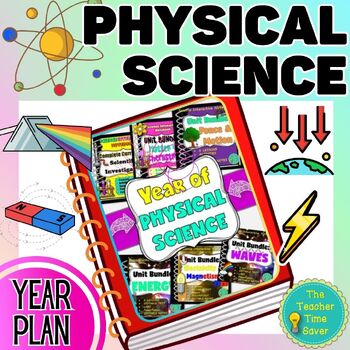Physical Science Interactive Notebook- NGSS Middle School Science Curriculum
- Zip
Also included in
- Looing for a complete Physical Science Unit Bundle to cover matter, forces of motion, energy, electricity, light and sound waves?! Do you need a start-to-finish guide to lead you on your science teaching journey or just need something to work with to make your own? This complete science bundle is fiPrice $60.00Original Price $358.68Save $298.68
Description
This comprehensive Physical Science Year Unit Plan is prepped and planned from start to finish guiding you and your students through a discovery of 6 unit plans covering: States and Phases of Matter (Periodic Table of Elements, atom structure, bonds), Forces of Motion (Laws of Motion, Gravity, friction), Energy (Simple Machines, Conservation of Energy), Electricity (circuits, currents) and Light and Sound Waves.
Each unit with its backwards design allows students to create a working portfolio or science interactive notebook. No two student notebooks will look like!
New or veteran science teachers benefit with this all-in-one, ready-to-print-and-go science resource to use instantly, while offering student and teachers autonomy and flexibility.
For teachers who need to modify the units or topics, editable versions of the notes, slide presentation, tests and quizzes are all included in each unit plan.
Each UNIT consistently includes:
- Pacing Guide
- Table of Contents
- Student Score Sheet
- Pre-assessment/Post-Assessment
- 5 Lessons
- Boom Cards/Digital Task Cards
- Projects with directions and rubrics
- Summative Assessment (Editable Test)
- Reflection Activity
Each LESSON includes:
- 2 warm ups (pre-post assessments)
- a set of notes (editable version included)
- a slide presentation (editable version included)
- an activity (write/art/color/reflection)
- Formative Assessment (5 multiple choice questions)
- essential questions
UNITS and topics include:
MATTER
- Lesson- Properties of Matter
- Lesson States of Matter
- Lesson- Atom Structure
- Lesson- Bohr's Diagram
- Lesson- Atom Bonds
- Lesson- Periodic Table
- Lesson- Elements, Compounds and Mixtures
- Lesson- Chemical Reaction
- Project- Phases of Matter Comic
- Project- Atom Model
- Activity- Periodic Table Battleship
- Project- Chemical Reaction Restaurant Menu
- Activity- Periodic Table Brain Break Activity
- Activity- "The Last Element Standing"
- Project- Chemical Reaction Holiday Menu
- Parts of the Atom Coloring Notes and Slides
- Periodic Table Coloring Notes and Slides
FORCE AND MOTION
- Lesson- Speed and Motion
- Lesson- Acceleration and Velocity
- Lesson- Force and Friction
- Lesson- Net Balances
- Lesson- Newton's Laws of Motion
- Activity: Obstacle Coarse Challenge
- Project- Trivia Board Game Review
ENERGY
- Lesson- Law of Conservation of Energy
- Lesson- Kinetic and Potential Energy
- Lesson- Work
- Lesson- Power
- Lesson- Simple Machines
- Energy Cartoon Project
- Lab: Kinetic and Potential Energy Ball Drop
ELECTRICITY AND MAGNETISM
- Lesson- Electricity
- Lesson- Electrical Current
- Lesson- Electric Circuit
- Lesson- Batteries
- Lesson- Magnets and Electromagnets
- Creative Writing Cartoon Project
WAVES- LIGHT AND SOUND
- Lesson- Waves
- Lesson- Property of Waves
- Lesson- Property of Light
- Lesson- Refraction and Diffraction
- Lesson- Sound
- Project- Trivia Board Game
- Absorb and Reflect Light Lab Activity
- Cootie Catcher- Type of Waves
- Cootie Catcher- Parts of Waves
SCIENTIFIC PROCESS
- Lesson- Lab Safety Lesson
- Lesson- Lab Materials and Measurement
- Lesson- Metric Measurements
- Lesson- Scientific Method
- Lesson- Controlled Experiment
- Lesson- Magnets and Electromagnets
- Creative Writing Review Project
Plus, a Physical Science Coloring Page and ABC Vocabulary Word Wall are included!
Stay connected to be the first to know about store discounts, free products, and product launches!
☆ The Teacher Time Saver Store
Terms of Use:
Copyright © The Teacher Time Saver. All rights reserved by author. This product is to be used by the original down-loader only. Copying for more than one teacher, classroom, department, school, or school system is prohibited. This product may not be distributed or displayed digitally for public view. Failure to comply is a copyright infringement and a violation of the Digital Millennium Copyright Act (DMCA). Clip art and parts included in the PDFs are copyrighted and cannot be taken and used outside this download without permission or license. Intended for classroom and personal use ONLY.






